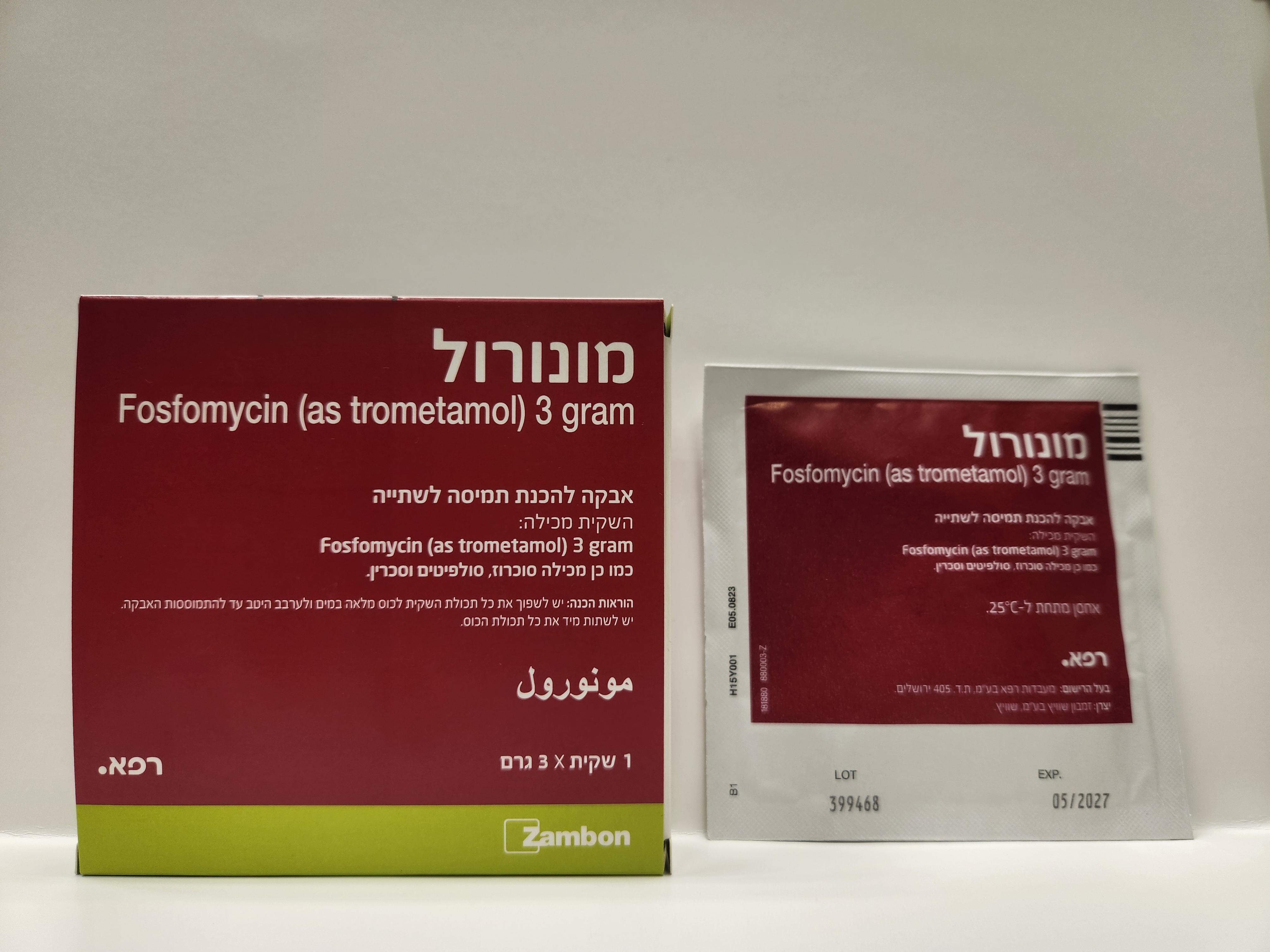Quest for the right Drug

מונורול MONUROL (FOSFOMYCIN AS TROMETAMOL)
תרופה במרשם
תרופה בסל
נרקוטיקה
ציטוטוקסיקה
צורת מתן:
פומי : PER OS
צורת מינון:
אין פרטים : POWDER FOR ORAL SOLUTION
עלון לרופא
מינוניםPosology התוויות
Indications תופעות לוואי
Adverse reactions התוויות נגד
Contraindications אינטראקציות
Interactions מינון יתר
Overdose הריון/הנקה
Pregnancy & Lactation אוכלוסיות מיוחדות
Special populations תכונות פרמקולוגיות
Pharmacological properties מידע רוקחי
Pharmaceutical particulars אזהרת שימוש
Special Warning עלון לרופא
Physicians Leaflet
Pharmacological properties : תכונות פרמקולוגיות
Pharmacodynamic Properties
5.1 Pharmacodynamic properties Pharmacotherapeutic group: Antibacterials for systemic use - other antibacterials. ATC code: J01XX01 Mechanism of action: Fosfomycin exerts a bactericidal effect on proliferating pathogens by preventing the enzymatic synthesis of the bacterial cell wall. Fosfomycin inhibits the first stage of intracellular bacterial cell wall synthesis by blocking peptidoglycan synthesis. Fosfomycin is actively transported into the bacterial cell via two different transport systems (the sn-glycerol-3-phosphate and hexose-6 transport systems). Pharmacokinetic/pharmacodynamic relationship Limited data indicate that fosfomycin most likely acts in a time-dependent manner. Mechanism of resistance Main mechanism of resistance is a chromosomal mutation causing an alteration of the bacterial fosfomycin transport systems. Further resistance mechanisms, which are plasmid- or transposon- borne, cause enzymatic inactivation of fosfomycin by binding the molecule to glutathione or by cleavage of the carbon-phosphorus-bond in the fosfomycin molecule, respectively. Cross-resistance Cross-resistance between fosfomycin and other antibiotic classes is not known. Susceptibility testing breakpoints The susceptibility breakpoints established by the European Committee on Antimicrobial Susceptibility Testing are as follows (EUCAST breakpoint table version 11): Species susceptible resistant Enterobacterales < 8 mg/L > 8 mg/L Prevalence of acquired resistance The prevalence of acquired resistance of individual species may vary geographically and over time. Local information about the resistance situation is therefore necessary, particularly in order to ensure appropriate treatment of severe infections. The following table is based on data from surveillance programs and studies. It comprises organisms relevant for the approved indications: Commonly susceptible species Aerobic Gram-negative microorganisms Escherichia coli Species in which acquired resistance may be a problem Aerobic Gram-positive microorganisms Enterococcus faecalis Aerobic Gram-negative microorganisms Klebsiella pneumonia Proteus mirabilis Inherently resistant species Aerobic Gram-positive microorganisms Staphylococcus saprophyticus
Pharmacokinetic Properties
5.2 Pharmacokinetic properties Absorption After single-dose oral administration, fosfomycin trometamol has an absolute bioavailability of about 33-53%. Rate and extent of absorption are reduced by food, but the total amount of active substance excreted in the urine over time is the same. Mean urinary fosfomycin concentrations are maintained above an MIC threshold of 128 μg/mL for at least 24 h post 3 g oral dose in either the fasting or fed state, but the time to reach maximal concentrations in urine are delayed by 4 h. Fosfomycin trometamol undergoes enterohepatic recirculation. Distribution Fosfomycin does not appear to be metabolised. Fosfomycin is distributed to tissues including the kidneys and bladder wall. Fosfomycin is not bound to plasma proteins and crosses the placental barrier. Elimination Fosfomycin is excreted unchanged mainly via the kidneys by glomerular filtration (40-50% of the dose is found in the urine) with an elimination half-life of about 4 hours after oral use and to a lesser extent in faeces (18-28% of the dose). Even if food delays drug absorption, the total amount of drug excreted in the urine over time is the same. Special populations In patients with impaired renal function, the elimination half-life is increased proportionally to the degree of renal insufficiency. Urinary concentrations of fosfomycin in patients with impaired renal function remain effective for 48 hours after a usual dose if creatinine clearance is above 10 ml/min. In older people fosfomycin clearance is reduced in line with the age related reduction in renal function.

פרטי מסגרת הכללה בסל
התרופה תינתן לנשים הרות לשם טיפול בזיהומים בדרכי השתן.
מסגרת הכללה בסל
התוויות הכלולות במסגרת הסל
| התוויה | תאריך הכללה | תחום קליני | Class Effect | מצב מחלה |
|---|---|---|---|---|
| התרופה האמורה תינתן לנשים הרות לשם טיפול בזיהומים בדרכי השתן. | 01/03/2002 |
שימוש לפי פנקס קופ''ח כללית 1994
לא צוין
תאריך הכללה מקורי בסל
01/03/2002
הגבלות
תרופה מוגבלת לרישום ע'י רופא מומחה או הגבלה אחרת
מידע נוסף
עלון מידע לצרכן
25.05.15 - עלון לצרכן אנגלית 25.05.15 - עלון לצרכן עברית 25.05.15 - עלון לצרכן ערבית 17.11.22 - עלון לצרכן עברית 04.04.23 - עלון לצרכן אנגלית 04.04.23 - עלון לצרכן עברית 04.04.23 - עלון לצרכן ערבית 15.05.24 - עלון לצרכן עברית 21.09.24 - עלון לצרכן אנגלית 21.09.24 - עלון לצרכן עברית 21.09.24 - עלון לצרכן ערבית 06.06.13 - החמרה לעלון 17.11.22 - החמרה לעלון 15.05.24 - החמרה לעלוןלתרופה במאגר משרד הבריאות
מונורול